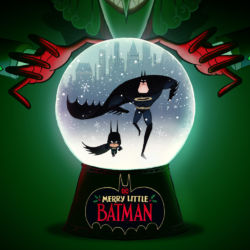Before we begin, a few notes: I have not read the “Demon Slayer: Kimetsu no Yaiba” manga, or watched the anime. (If you’re interested in a look at the whole comic, I recommend clicking here.) This review is written from the perspective doubtless shared by many of the viewers who propelled the film to become the highest-grossing movie in Japanese history: it is unlikely many of them were fans, and simply watched it because it offered a brief escape from the stress of COVID-19 pandemic. Unlike them, I watched the film in English: not much control over a digital rental there I’m afraid.
Going in, all I knew was the series was about Tanjiro Kamado, a samurai boy, who seeks to cure his sister Nezuko after she was afflicted with a vampiric curse: the movie takes a while to (re)establish this, aside from a brief mention of her inhabiting his wooden backpack, which we eventually learn is because “demons” cannot survive in sunlight. Instead, the first quarter of the movie focuses on reintroducing Tanjiro; his cowardly blonde sidekick Zenitsu; and the feral, obnoxiously aggressive sidekick Inosuke, who wears a boar’s head for a mask, as they board the titular steam train to Tokyo. There, they meet Mr. Rengoku, a seasoned demon slayer with flaming red-and-blonde hair, who is tracking several monsters on board.
The movie roughly falls into three episodic segments, after Rengoku dispatches a couple of monsters and agrees to mentor the boys: first, they all fall asleep, and find their dreams invaded by desperate children working for the lead villain Enmu, a demon who promises them peace if they ensure our heroes never wake up. This section, which resembles a cross between Inception and the Superman story ‘For the Man Who Has Everything,’ offers a look at Tanjiro and Rengoku’s backstories, with Tanjiro in particular fighting a compelling battle against his desire to become lost in the memories of his late family; we also get a comedic insight into Zenitsu and Inosuke’s mental landscapes.
The next chapter marks an extended duel between Tanjiro and Enmu, which escalates as Enmu reveals he’s bonded himself with the train, transforming it into a gnarly, Resident Evil-style setting where his congealed flesh-and-blood sprouts worm-like limbs and hypnotic eyes that surround our heroes. It’s gross but appropriately nightmarish imagery that offers a truly diabolical challenge (namely, have you ever wondered if you can wake up with your eyes closed?), which builds to a truly cathartic climax — except, of course, it isn’t, with 45 minutes still left to go of this two-hour film.
Another, significantly more powerful, and poorly foreshadowed demon shows up, and battles Rengoku in a gruelling fight-to-the-death — it’s here the film really goes off the rails (no pun intended), as it seems to decide Rengoku is the protagonist in spite of his minimal screentime, and as a result the extended brawl that these movie installments of TV anime always seem to become is even less engaging than usual. The film ends with one of the heroes losing his life in a Pyrrhic victory, and despite a stirring eulogy from Tanjiro, it feels as awkward as having to comfort a stranger at a funeral you were barely obligated to attend.
It’s very bizarre how this film — least of all the highest-grossing Japanese film of all time — ultimately becomes about the death of this supporting character: it seems it’s trying to be the anime equivalent of The Lord of the Rings: The Fellowship of the Ring, and Boromir’s death at the end of that movie, but it instead more closely resembles the unsatisfying stopgap of The Hobbit: An Unexpected Journey. Perhaps it would’ve been more poignant if I had watched the first season, but plenty of films manage to introduce and kill off a hero to devastating effect without any additional media beforehand.
The animation is pleasant, if unspectacular: the action is full of the usual kinetic lines emphasizing anger and ferocity in combat, and any moving background element is pretty obvious CG, because — unlike the fire and water sword attacks — they’re not cel-shaded, meaning they jar heavily with the traditionally animated characters. It’s not particularly great CG either; the effects here look less sophisticated than the 3D elements in early 2000s animation like Atlantis: The Lost Empire, Treasure Planet, or Steamboy. It may sound like I’m expecting too much from a TV spin-off, but it raises the question: why do this arc as a movie? It’s not a beginning, nor does it seem that pivotal to the overarching story.
All of this comes back to the big question I had going into this: why did it outgross superior films like Spirited Away or Your Name? Perhaps I’m overthinking it when the primary reason — the pandemic — is right there, but I did like the first two-thirds enough to wonder if it struck a greater chord: perhaps the protagonists getting lost in their dreams reflected a desire for the pandemic to be already over, and to be reunited with our families? Or maybe the theme of sacrifice reminded viewers of first-responders risking their lives to protect people from COVID-19? It’s certainly a more solemn and sedate experience than I expected, and in that respect it certainly captured the zeitgeist.
The true measure of success with an anime film is probably whether it inspires viewers to check out what’s come before, and in this case, the answer is maybe? The film ultimately exists to sate fans of the manga/TV show, rather than to make moviegoers check out what they’ve missed — the curious should definitely watch the first season instead.






